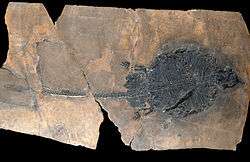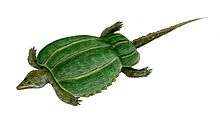Psephoderma
| Psephoderma Temporal range: Late Triassic | |
|---|---|
 | |
| P. alpinum fossil | |
| Scientific classification | |
| Kingdom: | Animalia |
| Phylum: | Chordata |
| Class: | Reptilia |
| Superorder: | †Sauropterygia |
| Order: | †Placodontia |
| Family: | †Placochelyidae |
| Genus: | †Psephoderma Meyer, 1858 |
| Species | |
| |
Psephoderma (meaning "pebbly skin", from the Ancient Greek psepho (ψῆφος), "pebbly", and derma (δέρμα), "skin" is a genus of placodont that was very similar to its relatives Placochelys and Cyamodus. Psephoderma had a flattened skull and a narrow, straight rostrum. Inside this skull, embedded in the jaws, were rounded teeth specialized for crushing the shellfish it ate. Unlike most placodonts, Psephoderma had a carapace that was divided into two pieces, one on the shoulders and back, another on the rear end. Psephoderma grew to 180 cm long and lived in the Late Triassic (Norian), about 210 million years ago. It was one of the last placodonts to live.

P. alpinum restoration
P. alpinum shell
External links
This article is issued from Wikipedia - version of the 7/21/2016. The text is available under the Creative Commons Attribution/Share Alike but additional terms may apply for the media files.